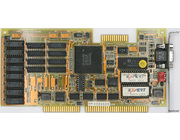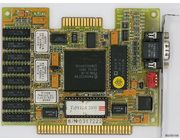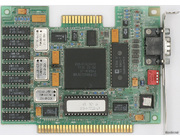Same chip as the one on the 8-bit ISA cards but it now it can probably use full-bandwidth. Benchmarks show a slight improvement over the 8-bit model. Unfortunately I don't know what the clock speed of this card is so I'm unsure if the performance-gain is due the wider 16-bit interface or a higher clock. Compared to the 8-bit model this card comes with 80NS RAM rather than 100NS.
There is a slight rendering problem which occurs with Wolfenstein 3D fade-effect between menu's and (I guess) horizontal refresh of effects in Quake.
FCCID on this card is DXL9IL LH6672. The PCB model number is probably LH6672. Presumably the DIP-switches are identical to the 8-bit card; which are mentioned here. This card is probably sold as 'TopVGA 2100'. > Read more
FCC ID is DX9IL LH6670. The 16-bit model ends with LH6672. Is pretty much the same as the 16-bit model. Same brand, same color, etc. Except for being 8-bit, having lower rated memory, and having oscillator crystals rather than a PLL it's identical.
This card was probably sold under the name 'TopVGA 2000'. > Read more
Great little card. Despite it's age and simplicity it works very well in early systems (XT, 286). I used to have this card in my ARC ProTurbo 88 until I switched over to a CGA-card + monitor to obtain true CGA-graphics.
If you're looking for the dip-switch configuration:
There is also a 16-bit ISA version of this card.Switch 1 Monitor Type. ON: Multi frequency, OFF: Standard VGA
Switch 2 VGA Mode Switching Style. ON: PS/2 Style - All modes available on all monitors, OFF: PC/AT Style - color on color, mono on mono
Switch 3 Not used - Set to OFF
Switch 4 (Not VGA Plus) 8bit vs 16bit AutoSense. ON: Auto sense 8/16bitBIOS access, OFF: Force 8bit BIOS access
I have benchmarked this card (read here) in a Pentium 100 and I think it's performance isn't that bad considering it's age. Of course there are many cards that are faster (and newer) but all in all you can have worse. Because I used a (relatively fast) Pentium 100 the PVGA1A is stretched to it's limits. If you use this card in an XT-class system it will run just fine and there would be no point in getting a faster VGA-card since the XT is the bottleneck anyway. > Read more


